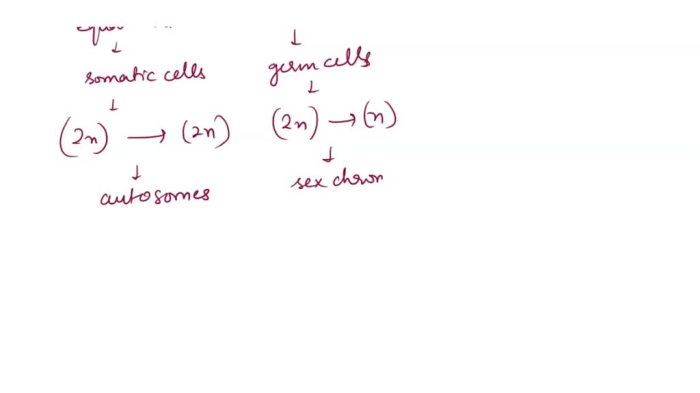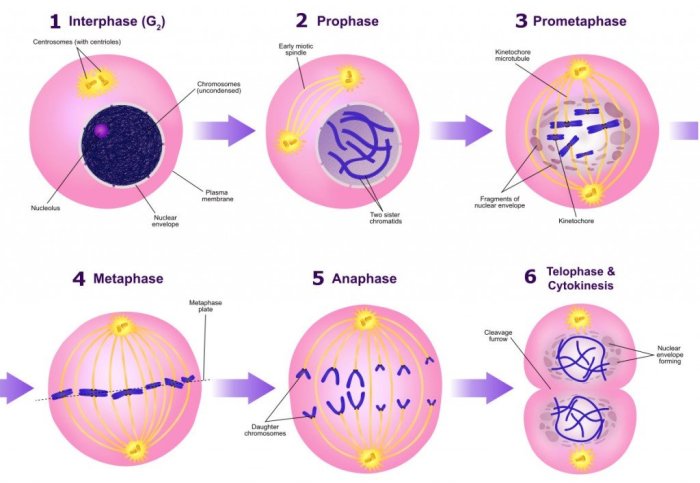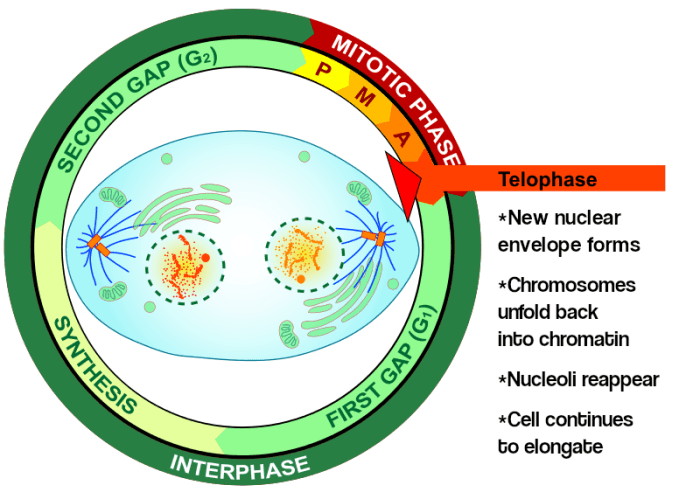Nuclear membrane reforms cytoplasm divides 4 daughter cells formed – Embarking on the intricate journey of cell division, we delve into the remarkable sequence of nuclear membrane reforms, cytoplasm division, and the formation of four distinct daughter cells. This process, orchestrated with precision, ensures the perpetuation of life and the inheritance of genetic material.
As cells prepare to divide, the nuclear membrane undergoes a series of transformations. The nuclear lamina, a meshwork of proteins, plays a pivotal role in reforming the nuclear envelope once chromosomes have been segregated. Simultaneously, the cytoplasm, the gel-like substance within the cell, undergoes division, guided by the cytoskeleton’s intricate network of fibers.
Nuclear Membrane Reforms

Nuclear membrane reformation is a crucial process that occurs during cell division. It involves the reassembly of the nuclear envelope, which separates the nuclear contents from the cytoplasm. The nuclear lamina, a meshwork of intermediate filaments, plays a pivotal role in this process.
Role of Nuclear Lamina in Nuclear Membrane Reformation, Nuclear membrane reforms cytoplasm divides 4 daughter cells formed
The nuclear lamina provides structural support to the nuclear envelope and facilitates the reassembly of the nuclear membrane during cell division. It consists of proteins such as lamin A, B, and C, which interact with nuclear membrane proteins and chromatin.
Diagram of Nuclear Membrane Reformation
[Diagram nuclear membrane reformation]
Cytoplasm Divides

Cytoplasm division, also known as cytokinesis, is the final stage of cell division. It involves the physical separation of the cytoplasm into two distinct daughter cells.
Role of Cytoskeleton in Cytoplasm Division
The cytoskeleton, a network of microtubules, microfilaments, and intermediate filaments, plays a critical role in cytoplasm division. Microtubules form the mitotic spindle, which segregates chromosomes during cell division, while microfilaments and intermediate filaments provide structural support and facilitate the constriction of the cytoplasm.
Diagram of Cytoplasm Division
[Diagram cytoplasm division]
4 Daughter Cells Formed
Daughter cell formation is the culmination of cell division, resulting in the creation of two genetically identical daughter cells.
Role of Mitotic Spindle in Daughter Cell Formation
The mitotic spindle, composed of microtubules, plays a central role in daughter cell formation. It aligns chromosomes during cell division and facilitates their separation into two sets, ensuring equal distribution of genetic material to each daughter cell.
Diagram of Daughter Cell Formation
[Diagram daughter cell formation]
Cytokinesis: Nuclear Membrane Reforms Cytoplasm Divides 4 Daughter Cells Formed

Cytokinesis is the physical separation of the cytoplasm into two daughter cells. It occurs differently in animal and plant cells.
Methods of Cytokinesis
- Animal cells:Cytokinesis occurs through a process called cleavage furrow, which involves the constriction of the plasma membrane by microfilaments.
- Plant cells:Cytokinesis occurs through the formation of a cell plate, a new cell wall that divides the cytoplasm.
Diagram of Cytokinesis
[Diagram cytokinesis]
FAQ Resource
What triggers the reformation of the nuclear membrane?
The completion of chromosome segregation during cell division initiates the reformation of the nuclear membrane.
How does the cytoskeleton contribute to cytoplasm division?
The cytoskeleton’s network of fibers, particularly microtubules and microfilaments, guides the division of the cytoplasm by forming a contractile ring that pinches the cell in two.
What is the significance of daughter cell formation?
Daughter cell formation ensures the equal distribution of genetic material and cellular components, allowing for the growth and development of new cells and tissues.